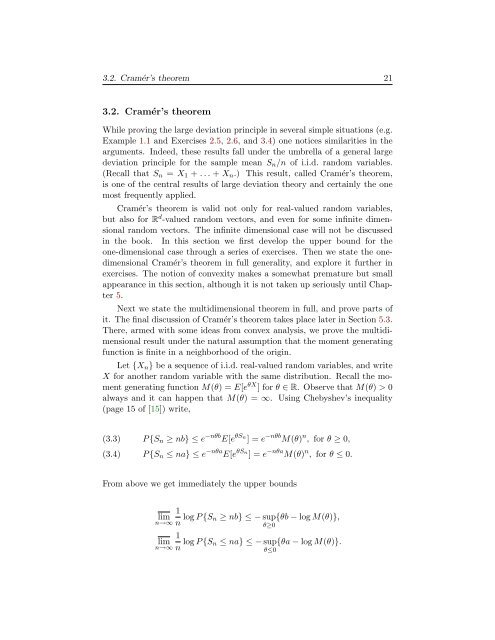A Course on Large Deviations with an Introduction to Gibbs Measures.
A Course on Large Deviations with an Introduction to Gibbs Measures.
A Course on Large Deviations with an Introduction to Gibbs Measures.
Create successful ePaper yourself
Turn your PDF publications into a flip-book with our unique Google optimized e-Paper software.
3.2. Cramér’s theorem 21<br />
3.2. Cramér’s theorem<br />
While proving the large deviati<strong>on</strong> principle in several simple situati<strong>on</strong>s (e.g.<br />
Example 1.1 <strong>an</strong>d Exercises 2.5, 2.6, <strong>an</strong>d 3.4) <strong>on</strong>e notices similarities in the<br />
arguments. Indeed, these results fall under the umbrella of a general large<br />
deviati<strong>on</strong> principle for the sample me<strong>an</strong> Sn/n of i.i.d. r<strong>an</strong>dom variables.<br />
(Recall that Sn = X1 + . . . + Xn.) This result, called Cramér’s theorem,<br />
is <strong>on</strong>e of the central results of large deviati<strong>on</strong> theory <strong>an</strong>d certainly the <strong>on</strong>e<br />
most frequently applied.<br />
Cramér’s theorem is valid not <strong>on</strong>ly for real-valued r<strong>an</strong>dom variables,<br />
but also for R d -valued r<strong>an</strong>dom vec<strong>to</strong>rs, <strong>an</strong>d even for some infinite dimensi<strong>on</strong>al<br />
r<strong>an</strong>dom vec<strong>to</strong>rs. The infinite dimensi<strong>on</strong>al case will not be discussed<br />
in the book. In this secti<strong>on</strong> we first develop the upper bound for the<br />
<strong>on</strong>e-dimensi<strong>on</strong>al case through a series of exercises. Then we state the <strong>on</strong>edimensi<strong>on</strong>al<br />
Cramér’s theorem in full generality, <strong>an</strong>d explore it further in<br />
exercises. The noti<strong>on</strong> of c<strong>on</strong>vexity makes a somewhat premature but small<br />
appear<strong>an</strong>ce in this secti<strong>on</strong>, although it is not taken up seriously until Chapter<br />
5.<br />
Next we state the multidimensi<strong>on</strong>al theorem in full, <strong>an</strong>d prove parts of<br />
it. The final discussi<strong>on</strong> of Cramér’s theorem takes place later in Secti<strong>on</strong> 5.3.<br />
There, armed <strong>with</strong> some ideas from c<strong>on</strong>vex <strong>an</strong>alysis, we prove the multidimensi<strong>on</strong>al<br />
result under the natural assumpti<strong>on</strong> that the moment generating<br />
functi<strong>on</strong> is finite in a neighborhood of the origin.<br />
Let {Xn} be a sequence of i.i.d. real-valued r<strong>an</strong>dom variables, <strong>an</strong>d write<br />
X for <strong>an</strong>other r<strong>an</strong>dom variable <strong>with</strong> the same distributi<strong>on</strong>. Recall the moment<br />
generating functi<strong>on</strong> M(θ) = E[e θX ] for θ ∈ R. Observe that M(θ) > 0<br />
always <strong>an</strong>d it c<strong>an</strong> happen that M(θ) = ∞. Using Chebyshev’s inequality<br />
(page 15 of [15]) write,<br />
(3.3)<br />
(3.4)<br />
P {Sn ≥ nb} ≤ e −nθb E[e θSn ] = e −nθb M(θ) n , for θ ≥ 0,<br />
P {Sn ≤ na} ≤ e −nθa E[e θSn ] = e −nθa M(θ) n , for θ ≤ 0.<br />
From above we get immediately the upper bounds<br />
1<br />
lim<br />
n→∞ n log P {Sn ≥ nb} ≤ − sup{θb<br />
− log M(θ)},<br />
θ≥0<br />
1<br />
lim<br />
n→∞ n log P {Sn ≤ na} ≤ − sup{θa<br />
− log M(θ)}.<br />
θ≤0
















